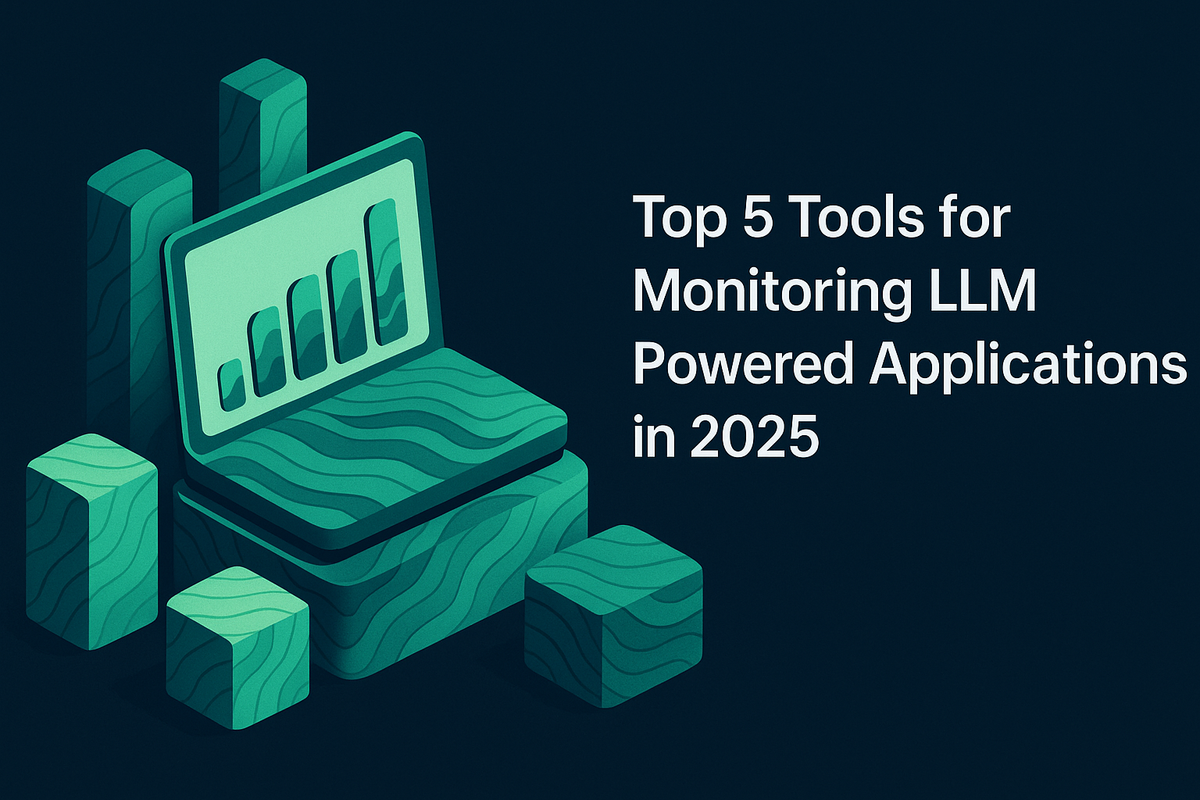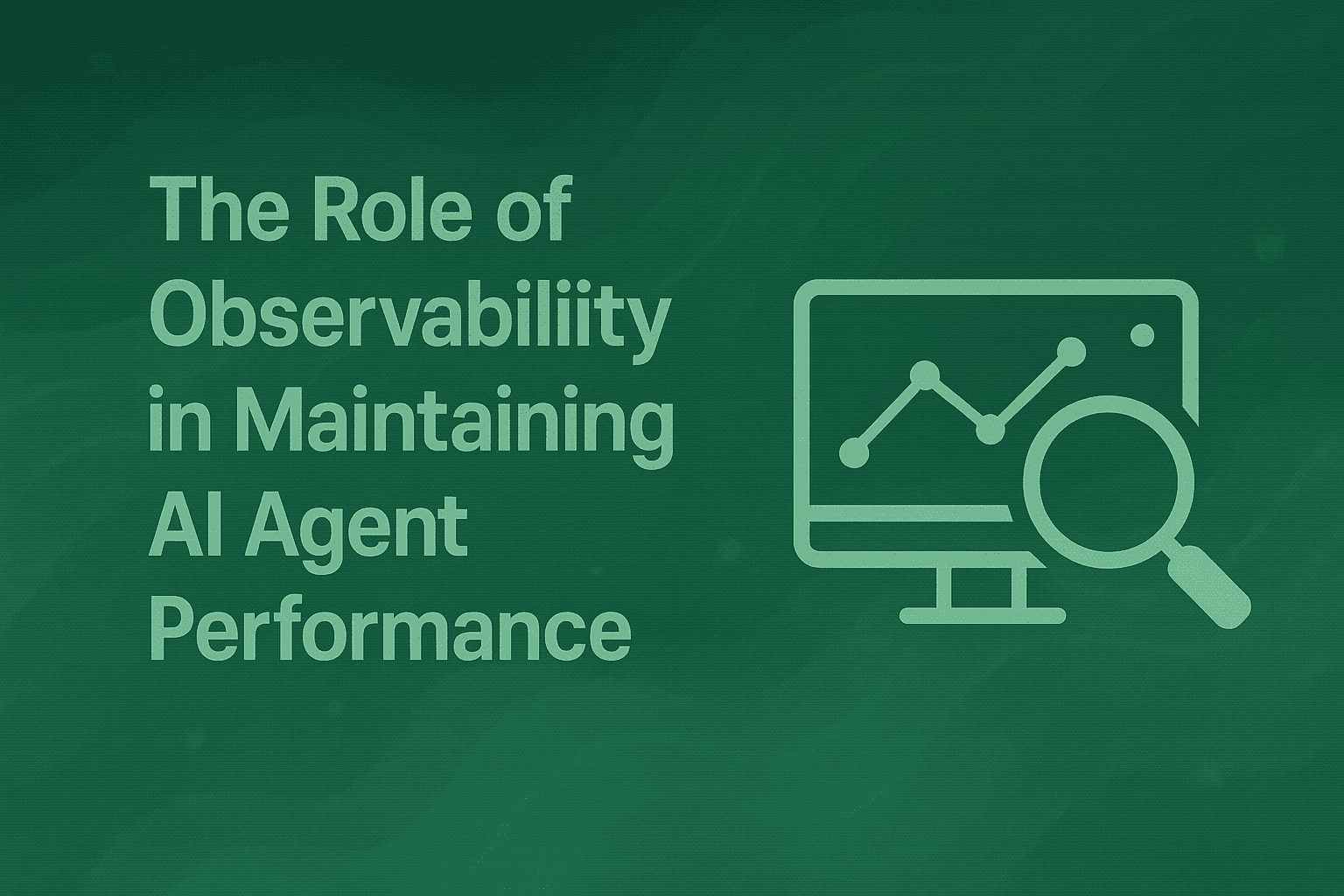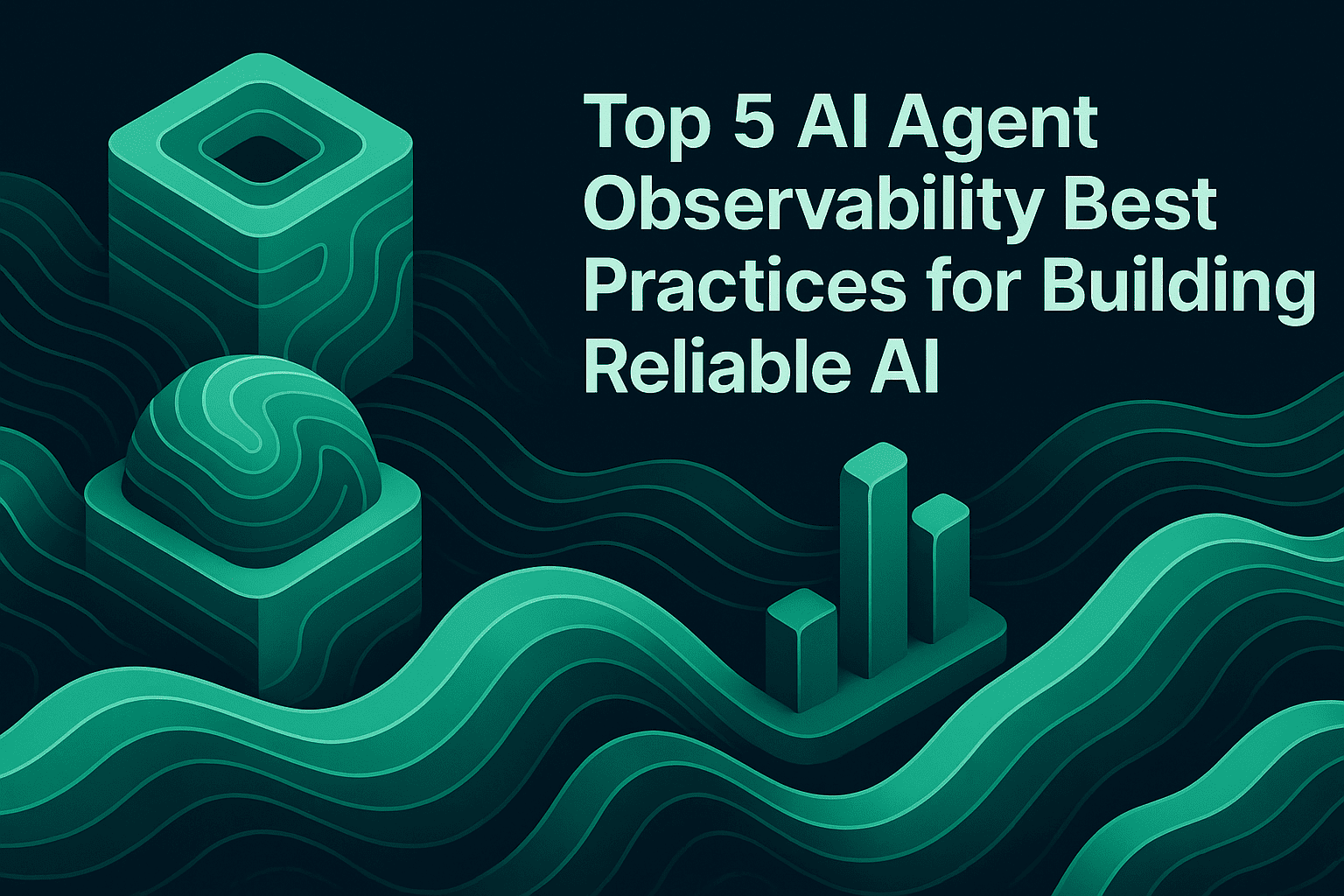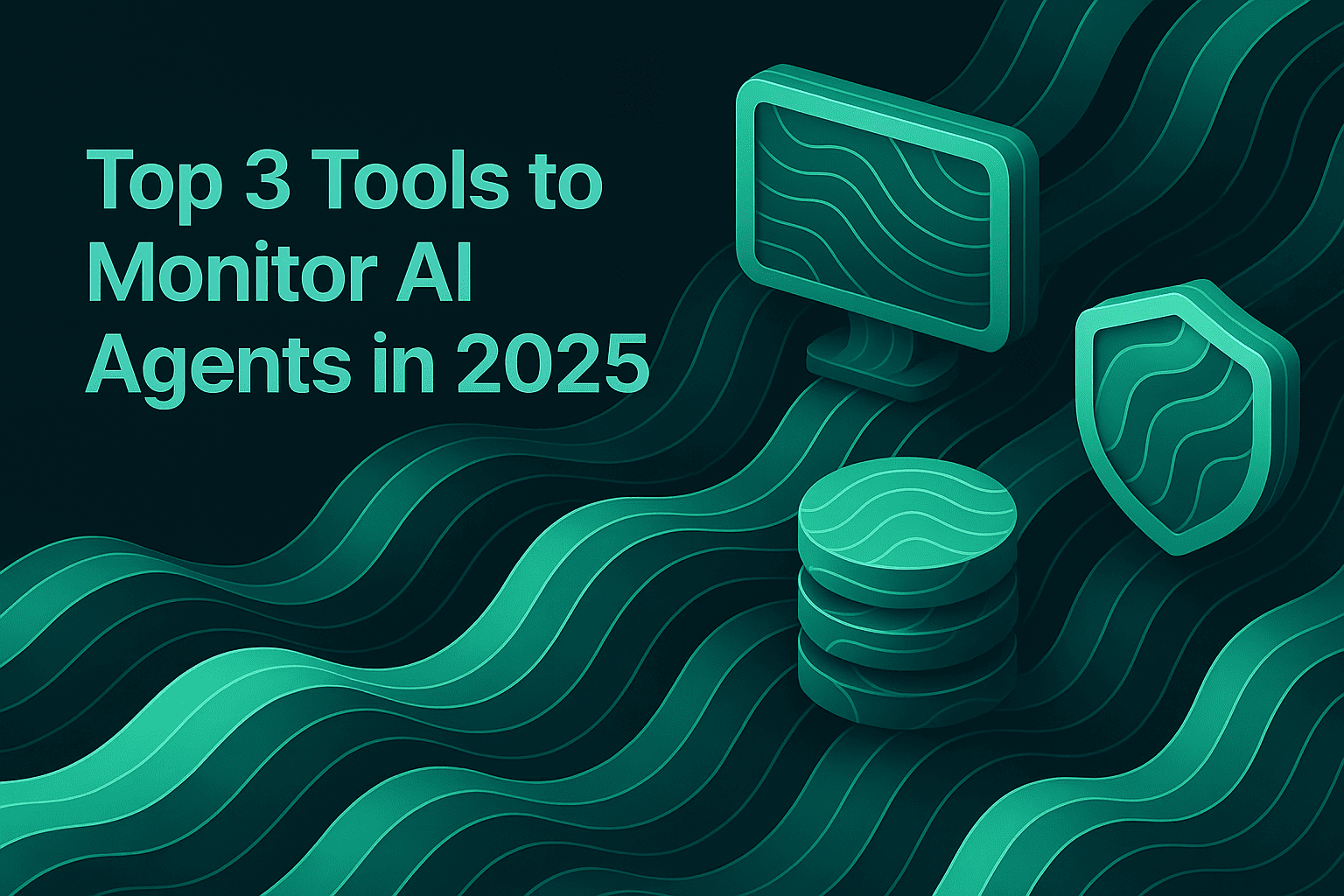Top 5 Tools for Monitoring LLM Powered Applications in 2025

Large language models are rapidly becoming central to enterprise operations. ChatGPT alone had over 400 million weekly active users as of February 2025, while AI-powered features now appear across countless production applications. This widespread adoption has made AI monitoring a critical requirement for organizations deploying LLM-powered systems at scale.
AI monitoring extends beyond traditional application performance monitoring to address the unique challenges of generative AI systems. These tools capture and analyze model behavior, track token usage and costs, evaluate output quality, and provide visibility into the complete request lifecycle. Without robust monitoring frameworks, organizations risk deploying AI systems that fail silently, generate harmful outputs, or gradually drift from their intended behavior.
This guide examines the top five LLM monitoring tools available in 2025, evaluating their capabilities, integration approaches, and ideal use cases to help teams select the right solution for their production AI applications.
Essential Capabilities for LLM Monitoring
Effective LLM observability requires tools that address both operational monitoring and quality assessment. Organizations should evaluate monitoring platforms based on several critical capabilities.
Real-Time Performance Tracking
An observability solution should be capable of tracking and monitoring an LLM's performance in real time using metrics like accuracy, precision, recall, and F1 score, along with specialized metrics such as perplexity or token costs. Performance monitoring must capture latency across different request types, throughput under varying load conditions, and error rates across multiple failure modes.
Comprehensive Tracing and Debugging
Modern observability platforms support tracing across complex workflows, using intuitive trace views to enable complete understanding of multi-step AI agent interactions. Distributed tracing becomes essential for multi-agent systems where understanding interaction patterns determines system reliability. Effective agent tracing captures prompt inputs, model parameters, tool invocations, and response outputs to provide complete visibility into agent behavior.
Cost and Token Management
Token consumption directly impacts operational costs for LLM applications. Monitoring tools must track token usage patterns across different request types, attribute costs to specific features or customers, and identify optimization opportunities. Organizations deploying multiple models require unified cost visibility across providers to implement effective budget controls.
Quality Evaluation and Safety
Debugging and error tracking functions allow for in-depth analysis of model outputs, especially when they deviate from expected behaviors, helping developers refine prompts, adjust training data, or apply targeted fixes. Quality monitoring should detect hallucinations, assess response relevance, identify potential bias in outputs, and flag harmful content before it reaches end users. Advanced platforms combine automated evaluation with human-in-the-loop review workflows to ensure comprehensive quality assessment.
Top 5 LLM Monitoring Tools
1. Maxim AI
Maxim AI provides an end-to-end platform for AI simulation, evaluation, and observability, enabling teams to ship AI agents reliably and more than five times faster. The platform addresses the complete AI lifecycle from experimentation through production monitoring, making it particularly valuable for organizations building complex multi-agent systems.
Core Monitoring Capabilities
Maxim's observability suite empowers organizations to monitor real-time production logs and run them through periodic quality checks to ensure reliability. The platform provides distributed tracing for multi-agent systems, enabling teams to track, debug, and resolve live quality issues with real-time alerts to minimize user impact. Organizations can create multiple repositories for different applications, logging and analyzing production data through comprehensive tracing infrastructure.
Unified Lifecycle Approach
Maxim distinguishes itself through tight integration between observability and other lifecycle stages. The experimentation platform enables rapid prompt engineering with version control, deployment management, and A/B testing capabilities. Teams can organize and version prompts directly from the UI, deploy changes without code modifications, and compare output quality, cost, and latency across various combinations of prompts, models, and parameters.
The simulation capabilities allow teams to test agents across hundreds of scenarios and user personas before deployment. Organizations can simulate customer interactions, evaluate agents at a conversational level, and re-run simulations from any step to reproduce issues and identify root causes.
Advanced Evaluation Framework
Maxim provides a unified framework for machine and human evaluations, allowing teams to quantify improvements or regressions before deployment. The platform offers off-the-shelf evaluators through an evaluator store alongside support for custom evaluators suited to specific application needs. Organizations can measure quality using AI, programmatic, or statistical evaluators, visualize evaluation runs across multiple versions, and conduct human evaluations for nuanced assessments.
Data Management Integration
The Data Engine enables seamless data curation, allowing teams to import multi-modal datasets, continuously curate datasets from production logs, enrich data through labeling workflows, and create data splits for targeted evaluations. This integration ensures that production insights directly improve agent quality over time through systematic data management.
Gateway Infrastructure
For organizations managing multiple LLM providers, Bifrost provides a high-performance AI gateway with unified observability. Bifrost offers a single OpenAI-compatible API for 12+ providers, automatic failover and load balancing, semantic caching to reduce costs and latency, and native Prometheus metrics with distributed tracing. This architecture enables centralized LLM monitoring regardless of underlying provider, simplifying multi-provider deployments while maintaining comprehensive visibility.
2. Langfuse
Langfuse is an open source LLM observability tool, providing tracing, evaluations, prompt management, and metrics to debug and improve LLM applications. The platform has established itself as a choice for teams seeking open source solutions with extensive feature sets and community support.
Langfuse offers comprehensive session tracking capabilities, capturing complete conversation threads and user interactions over time. The platform provides batch export functionality for analysis in external systems, maintains SOC2 compliance and ISO 27001 certification for enterprise security requirements, and includes a prompt playground for interactive experimentation.
The tool integrates seamlessly with multiple frameworks, enabling rapid deployment into existing development workflows. Organizations benefit from the active open source community, which contributes to ongoing feature development and provides extensive documentation for implementation guidance.
3. Arize Phoenix
Phoenix backed by Arize AI is an open source LLM observability platform, designed from the ground up for developers working with complex LLM pipelines and RAG systems. The platform provides specialized capabilities for evaluating, troubleshooting, and optimizing LLM applications through a user interface designed for visualization and experimentation.
The platform visualizes LLM traces and runs during development, enabling teams to understand model behavior before production deployment. Phoenix works well with OpenTelemetry thanks to a set of conventions and plugins that are complimentary to OpenTelemetry, meaning Phoenix can more easily integrate into existing telemetry stacks.
The platform connects to Arize's broader AI development ecosystem, providing observability tools for machine learning and computer vision alongside LLM monitoring. This integration makes Phoenix particularly valuable for organizations working across multiple AI modalities or teams transitioning from traditional ML to generative AI applications.
4. Datadog
Datadog is an infrastructure and application monitoring software that has expanded its integrations into the world of LLMs and associated tools, providing out-of-the-box dashboards for LLM observability. Organizations already using Datadog for infrastructure monitoring can enable OpenAI usage tracing with simple configuration changes, maintaining unified visibility across their entire technology stack.
The platform provides LLM Chain application programming monitoring capabilities that trace entire AI pipelines with full context of prompts, responses, embeddings, and intermediate calls. Datadog implements quality and security checks including native analysis for hallucinations, harmful content, PII leaks, and policy violations on model outputs. The platform combines LLM-specific metrics such as cost per request and token counts with standard telemetry including infrastructure and application logs.
Organizations benefit from Datadog's mature ecosystem of integrations, enabling correlation between LLM performance and underlying infrastructure health. The platform's pricing depends on metrics and traces consumption, scaling with usage patterns rather than fixed per-user costs. However, out-of-the-box compatibility remains restricted to top providers like OpenAI and popular frameworks like LangChain, potentially limiting applicability for organizations using diverse LLM providers.
5. Helicone
Helicone is an open source platform for monitoring, debugging, and improving LLM applications. The tool provides logging, monitoring, and debugging capabilities designed specifically for teams building production LLM applications. Helicone focuses on simplicity and ease of integration, enabling rapid deployment with minimal configuration overhead.
The platform captures detailed request and response data, tracks token usage and costs across providers, and provides visualization tools for understanding usage patterns. Organizations can implement Helicone as a proxy layer, capturing LLM traffic without modifying application code extensively. This approach enables monitoring without requiring deep integration into existing codebases.
Helicone offers both cloud-hosted and self-hosted deployment options, providing flexibility for organizations with specific security or data residency requirements. The platform integrates with major LLM providers including OpenAI, Anthropic, and others through a unified interface, simplifying multi-provider monitoring implementations.
Selecting the Right Monitoring Solution
The choice of an LLM monitoring tool should align with your organization's current needs and future trajectory. Rather than selecting based on feature checklists alone, teams should evaluate how monitoring integrates with their broader AI development workflow and whether the platform can scale alongside their applications.
Matching Tools to Development Maturity
Organizations at different stages of AI adoption require fundamentally different capabilities from their monitoring infrastructure. Teams in early experimentation phases benefit most from platforms that unify prompt engineering, evaluation, and monitoring within a single workflow. This integration eliminates the friction of moving between disconnected tools as applications progress from prototype to production, reducing time-to-deployment while establishing quality baselines from the start.
Production-focused teams operating mature AI applications need robust agent observability with comprehensive distributed tracing, real-time alerting, and the ability to correlate quality issues across complex multi-agent interactions. However, monitoring alone addresses only half the challenge. The most effective approach combines production monitoring with continuous evaluation capabilities, enabling teams to detect issues in real-time and systematically improve agent behavior through data-driven iteration.
Enterprises deploying sophisticated multi-agent systems face unique challenges that point-solution monitoring tools cannot adequately address. These organizations require end-to-end platforms that connect agent simulation, pre-production testing, and production monitoring through unified data management. Maxim's architecture specifically addresses this need by enabling teams to simulate agent behavior across hundreds of scenarios, evaluate quality using both automated and human review, and monitor production performance, all while maintaining continuous feedback loops that improve agent quality over time.
Infrastructure Integration Considerations
Teams building on existing observability infrastructure should evaluate whether adding LLM-specific monitoring justifies operating separate platforms or whether unified visibility delivers greater operational value. Organizations already standardized on comprehensive monitoring solutions like Datadog may prioritize consolidation, accepting some limitations in LLM-specific features in exchange for reduced operational complexity.
However, teams focused primarily on AI application development often find that AI-native platforms deliver superior capabilities for agent debugging, prompt optimization, and quality evaluation. Platforms built specifically for AI workflows provide deeper insights into model behavior, more sophisticated evaluation frameworks, and tighter integration between experimentation and production monitoring. Organizations seeking vendor-neutral approaches can leverage OpenTelemetry-compatible solutions that provide flexibility without sacrificing LLM-specific capabilities.
For teams managing multiple LLM providers, gateway infrastructure becomes critical. Bifrost addresses this requirement by providing unified LLM monitoring across 12+ providers through a single OpenAI-compatible API, with automatic failover, semantic caching, and native observability integration. This architecture enables centralized monitoring regardless of underlying providers while reducing operational complexity.
Making the Strategic Choice
Selecting monitoring infrastructure represents a strategic decision about how your organization approaches AI quality and reliability. Teams should evaluate not only immediate monitoring needs but also how the platform supports evolving requirements as applications mature and complexity increases. The right solution provides immediate value for current production needs while offering flexibility for future capabilities around multi-agent orchestration, advanced evaluation, and systematic quality improvement.
Organizations prioritizing speed of iteration and cross-functional collaboration between engineering and product teams should evaluate platforms designed for intuitive workflows that enable non-technical stakeholders to contribute to AI quality without creating engineering dependencies. Teams focused primarily on operational monitoring may find specialized solutions sufficient, while organizations treating AI as core product functionality benefit from platforms that integrate monitoring with the broader AI lifecycle.
Conclusion
LLM monitoring has evolved from basic logging to comprehensive observability frameworks that address the unique challenges of generative AI systems. The tools examined in this guide represent different approaches to monitoring, from end-to-end lifecycle platforms to specialized open source solutions, each offering distinct advantages for specific use cases.
Organizations deploying production AI applications should implement monitoring from the earliest development stages, establishing baselines for performance and quality before problems emerge. Effective monitoring enables teams to detect issues early, optimize costs through token usage analysis, maintain quality through automated evaluation, and build trust through transparency into system behavior.
The rapid evolution of LLM capabilities and deployment patterns will continue driving innovation in monitoring tools. Teams should select platforms that provide flexibility for evolving requirements while delivering immediate value for current production needs. Platforms that integrate monitoring with experimentation and evaluation enable faster iteration cycles and more reliable deployments.
Ready to implement comprehensive monitoring for your AI applications? Schedule a demo to see how Maxim can help you ship reliable AI agents faster, or sign up to start monitoring your applications today.


